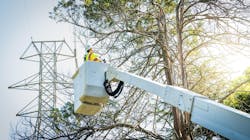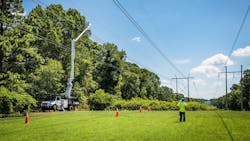Transmission Vegetation Management Transformation Part II
Duke Energy Corp. has a well-established and industry-recognized transmission vegetation management program that has enabled the utility to maintain a disciplined and consistent approach to managing vegetation along its transmission rights-of-way. Until recently, the utility’s approach to managing vegetation along transmission lines relied on interval-based maintenance with specifications that prescribed what work needed to be performed.
As operational challenges and customer expectations evolved, Duke Energy determined this time-tested approach was no longer sustainable. The utility needed to transform the way it planned and executed work. As part of a comprehensive business transformation initiative, Duke Energy changed its operational strategy, organizational alignment, technology solutions and program documentation. Advanced data analytics and an open-minded approach to business processes led to two technology-related efforts to support the transformation of the utility’s work practices: the implementation of an enterprise remote-sensing program (RSP) and development of a Work Planning, Analysis and Scheduling System (WorkPASS).
The RSP was featured in the first part of this two-part series in the June 2023 issue of T&D World. The second part of this article series focuses on WorkPASS.
WorkPASS Initiative
Once the RSP was established, the WorkPASS initiative kicked off to develop the tools, applications and predictive analytics necessary to manage the data, provide actionable execution information and support field mobile access to the data. WorkPASS consists of more than 20 task or workflow applications.
Each application and analytic solution falls within one of the following categories:
- Geospatial data management
- Data enrichment
- Risk predictions and optimization
- Work execution system.
- Geospatial Foundation
Geospatial data management applications in WorkPASS provide a platform to manage and access RSP data and imagery deliverables. Across Duke Energy’s four regions, 70 million to 100 million trees have been assessed for threats by the remote-sensing program and are managed in the WorkPASS geodatabase.
This database provides the foundation for all WorkPASS geospatial data and is integral to all data viewed, edited and updated through the applications.
Enriching The Data
Data enrichment provides analytics that enhance the RSP data with critical information for optimizing and executing the work. While the RSP data provides general insight into what the predicted work type will be (for example, mowing, herbicide, removal, trim), it is not sufficient to provide actionable
information for execution.
Risk Predictions And Optimization
Once the data enrichment process is finalized, the WorkPASS risk prediction analytics provide reliability risk values for fall-in threats along each transmission line. The analytics use a combination of variables to predict the reliability risk value and apply it at the tree-canopy polygon level. These values provide an input for annual work plan creation in the scenario planner tool. Additionally, the values are used by field personnel during work planning and marking.
To create an annual work plan, the scenario planning application uses tree-canopy reliability risk predictions and the enriched RSP data to evaluate numerous scenarios and to develop an optimized annual work plan for corridor management in each region. While the reliability risk predictions and RSP tree-canopy polygons can provide potential risk probability from threats for scenario planning, they also are important to understand and account for the impact or consequence if an outage were to occur.
To address this important variable, the Duke Energy Transmission Vegetation Management (TVM) organization created a line criticality index. This index is a weighted assessment of the consequences of an outage, which does not consider voltage as a factor. Once annual work plans are finalized, the scenario planning application optimizes the work plan for each region (multiyear planning also is supported) to include all the circuits and polygons that need to be addressed in the corridor management work plan.
Work Execution System
The WorkPASS work execution system provides solutions to plan and execute the corridor management and reactive management programs. Floor management is limited to field-planning tools in support of the interval-based program.
Once an annual work plan is published for corridor management in each region, a central hub called ROOTS allows users to assign, monitor and track work as it progresses through the work steps of planning, ready for work, assigned for work, ready for quality assurance (QA) and complete. In addition, ROOTS provides the ability to create an annual schedule for work plan completion and monitor actual progress against that plan.
Once work is assigned for planning in ROOTS, multiple mobile applications provide field users the ability to locate, field plan and mark corridor management work. These apps allow the field user to assess and change the predicted work units as site-specific and arboricultural conditions require. Upon completion of field work planning, ROOTS provides the ability to assign the work to a general foreperson, who has visibility of the assigned work in an app called LEAFOUT for execution and reporting of completed work. Completed work returns to ROOTS ready for QA, and once it is performed, the work can be either closed or sent back for rework as necessary.
Field planning and marking of reactive work findings is completed using the REACT field mobile app, with access to point cloud images. Following reactive work planning, the findings are available in ROOTS for work assignment and then in LEAFOUT for execution.
Duke Energy’s floor management program continues to use an interval-based maintenance approach, and it is important to note the RSP-derived tree-canopy polygons do not represent all the work that should be handled under the floor program. Currently, the WorkPASS applications are only focused on supporting the field work planning tasks for floor management.
End-to-End Management
Innovative technological, analytical and application solutions were implemented through the RSP and WorkPASS initiatives. They have provided a solid foundation to continue to adapt, transform and expand well into the future. Together, they have produced meaningful long-term benefits. With these implementations complete, Duke Energy TVM has gained the ability to manage each of the vegetation management programs with an end-to-end approach, from the initial identification of conditions to the closing of work orders. These solutions also provide the capability to create annual work plans with actionable deliverables.
The technology solutions have provided significant advantages over manual processes, such as spreadsheets or nonintegrated, task-specific applications previously used to manage TVM programs. An end-to-end approach removes subjectivity in assessing threats, provides common vegetation threat definitions across the enterprise, centralizes documentation and reduces human performance risk.
Probability Modeling
While transmission vegetation-related outages are rare and typically caused by off-rights-of-way (ROW) trees, they can have significant impact. To eliminate the impact, all identified fall-in threats from off-ROW trees would need to be removed or mitigated, which is neither practical nor possible. With the limited number of vegetation-related outages on transmission lines, using outage data to target specific circuits with a history of outage was not a viable option.
The WorkPASS initiative provided Duke Energy TVM the opportunity to explore options to proactively address, where possible, off-ROW threats. PREDICTIONS, a WorkPASS solution, employs risk modeling using a variety of datasets combined with RSP data to identify off-ROW tree threats most likely to cause a future outage. Using reliability risk probability modeling data during work planning is a way to explore opportunities to reduce the potential for outages. This approach is like a baseball coach stacking the lineup against a pitcher for the greatest opportunity for success.
Scenario Planning
With the transition to a condition-based approach for corridor management, simple prioritization methods used previously to adjust interval-based work plans were no longer sufficient. This led to another significant benefit from WorkPASS: the ability to consider different scenarios when creating annual corridor management work plans, and then optimizing and publishing those annual work plans.
One of the keys to increasing the value provided by scenario planning was separating vegetation threat probability of failure into two components: the integrity index (from on-ROW threats) and the reliability index (from off-ROW threats).
The scenario planning application provides flexibility to create an annual work plan that can be adjusted to meet constraints and objectives that include compliance adherence, risk reduction, cost control, specific threat targeting, reliability and integrity performance, and critical facilities. This functionality provides optimal annual work plans and valuable insights when mid-plan adjustments are needed.
Work Execution Benefits
Duke Energy has experienced numerous benefits using the work execution system applications to execute TVM work:
- Mobile access to data for field personnel
- Reduced need for spreadsheets
- Ability to create an annual schedule for the work plan
- Data access and workflow support for field work planning and marking
- Assignment of work to a general foreperson
- Web browser access to assigned work and for reporting completion of work.
Program Management Effectiveness
The greatest benefit may be the RSP and WorkPASS centralized database. The data provides insights into TVM programs that were not previously possible.
Access to reactive management program data has led to improvements already in the planning and execution of reactive work. The data will continue to provide information needed to improve each of the three TVM programs: corridor, floor and reactive management.
While the data supports improvement of processes, planning and execution for each of these three programs, the next step is to leverage the information to assess the effectiveness of TVM across all the programs. To that end, Duke Energy TVM has started leveraging the data to develop a TVM program effectiveness report. While still in the early stages of implementation, this report will focus on four areas of the program:
- Asset management (strategy)
- Program conditions
- Program reliability
- Work management (execution).
Three Crucial Elements
Duke Energy continues to enhance and transform its TVM program, and the ability to leverage technology will remain critical to the utility’s transformation efforts. TVM’s experience during implementation of the RSP and WorkPASS initiatives has demonstrated that fully leveraging technology requires more focus and planning than adopting an existing solution. To successfully leverage technology and derive the benefits, these three crucial elements must be considered:
Strategic direction defines the technology and business requirements. While the drivers for every utility’s TVM program can and will vary, a key strategy focus area for Duke Energy’s TVM was to implement an end-to-end, data-driven solution, addressing threats over a multiyear period to drive reliability and program effectiveness. With this strategic focus as a driver, the utility was able to begin with the end in mind, limiting the time needed to consider the art of the possible.
A deliberative approach to development and implementation is essential. This approach includes assessing options and desirability, determining viability, assessing feasibility and refining the solution. Following the assessment of options such as accuracy, data resolution or threat identification to meet work needs, a pilot or prescribed demo effort can be used to confirm viability and feasibility. Once viability and feasibility have been established, a pre-scale implementation provides an opportunity to refine the solution prior to full implementation, reducing the risks associated with user adoption.
Flexibility and adaptability need to be primary considerations when technical options and feasibility are being discussed during the development phase. Because technology changes quickly and base-use case needs will evolve, building flexibility into the solution is vital. From an enterprise utility perspective, ensuring the adaptability of the data and technology solutions for other potential use cases, such as asset protection, transmission line engineering, distribution VM and corporate geographic information systems also is extremely important when practically supported within the business case. Because other potential use-case needs were considered during the development of the RSP and WorkPASS, the TVM data, applications and systems are leveraged by other organizations, such as the transmission line engineering and asset protection teams.
Successful implementation of Duke Energy’s TVM’s RSP and WorkPASS initiatives was made possible by addressing these three crucial elements and employing a robust change management effort within the organization as the technology-related initiatives were developed and implemented. Together, the RSP and WorkPASS applications provide Duke Energy TVM with the foundation necessary to meet the challenges associated with ever-increasing expectations.
Timothy J. “Jack” Gardner is Duke Energy’s Manager for Transmission Vegetation Strategy and Support. His team is responsible for providing enterprise TVM strategy, business transformation, technology, and support. Gardner holds a BSCE degree from Virginia Tech and has been with Duke Energy for over 22 years, after 20 years at AEP. During his career, he has led and managed numerous Transmission Line, Vegetation and Remote Sensing initiatives, programs, and organizations. In addition to his current role, he led the WorkPASS development initiative as Product Owner, with several TVM Strategy personnel providing critical business process, technical, and change management direction during the development: Johnathan McQuaide, Bill Skrobutt, Alex Christie, Sherry Bumgardner, and Mark Ferrill.
About the Author
Jack Gardner
Timothy J. (Jack) Gardner is Duke Energy’s manager for Transmission Vegetation Strategy and Support. His team is responsible for providing enterprise TVM strategy, business transformation, technology, and support. In addition to leading the strategy and support functions, he also led TVM Business Transformation initiatives and managed the development and implementation of planning, analytics, and scheduling applications for TVM. Gardner holds a Bachelor of Science in Civil Engineering from Virginia Tech and has been with Duke Energy for 22 years, after 20 years at AEP. During his career, he has led and managed TVM Strategy and Support, TVM Regions, Transmission Line Construction and Maintenance, ROW Acquisition, Asset Protection, Aerial Patrol Programs, Regulatory Strategic Planning, Asset Management, Transmission GIS, Transmission Line Mechanic Training, Remote Sensing Programs (Mapping/LiDAR) with more than 110,000 circuit miles acquired, numerous enterprise technology and process improvement initiatives, and construction engineering and project management on several hundred miles of 69-765 kV transmission line and fiberoptic projects.


